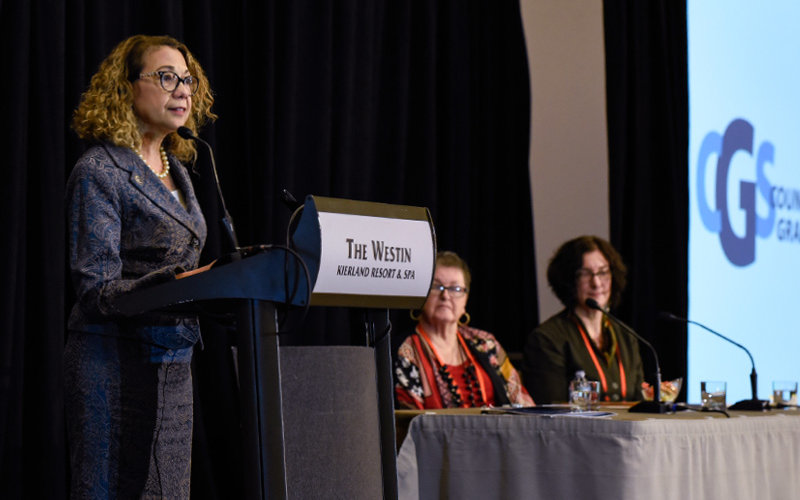
Last week, President Mildred García gave the keynote address at the Council of Graduate Schools’ annual meeting in Scottsdale, Arizona. Her speech, “Diversity Imperative in Graduate Education: The Need to Ensure Equity for All,” focused on how colleges and universities can motivate and help underrepresented students achieve their goals of a graduate education.
García recalled her own experiences as a grad student when she was told by a colleague, early in her career, that she was “aiming too high” in pursuing an advanced degree.
“I know that many of the diverse students you all represent face similar obstacles in pursuit of a graduate degree,” she told the audience. “This underscores the diversity imperative, not just in graduate education, but in the industries in which advanced degrees are required for professional success.
“That journey begins with all of us working toward a day when the faculty, staff and students in our graduate programs mirror the diverse peoples of this nation — whether pursuing advanced degrees in technology, sociology, the arts, the sciences or education.”
García encouraged the audience to break down the obstacles most women, low-income students and students of color face, not just in pursuing a graduate degree, but also in understanding and believing such a degree is even possible.
Using examples from her own past, she encouraged those in attendance to understand students in their language and space. That means, in some instances, holding workshops or orientations in other languages to involve families and encourage students.
One example, García cited, is Cal State Fullerton’s “Celebración Familiar,” a program that invites every first-year student who marked “Spanish” as the language spoken at home, to bring their parents and families to a pre-orientation at which subjects such as financial aid, student success programs, advising, how to get involved and more are covered — all in Spanish.
“Once you know your students in their language and space, you must ensure your faculty and staff mirror their diversity,” she said. “It’s all about validating people and letting them know they have potential and can succeed. We know our students actively seek out faculty and staff members who look like them, share similar backgrounds and can personally empathize with their plight.”
The top three pieces of advice that García gave to academic leaders to bolster participation and academic success are the following:
- Make sure your campus is flush with top-notch programs that mentor students into graduate schools;
- Make sure your passion — and that of your faculty and staff — is stirred by empowering undergraduate students to enter into graduate school, particularly those who come from underrepresented communities or are the first in their families to graduate from college; and
- We are obligated to speak out not just on moral grounds but by the very tenets we agreed to uphold when we accepted our leadership role.
“Today, our country is going through a difficult time, and those who are suspicious of diversity and fear the changing face of our nation have been emboldened to speak and lash out against it. I’m amazed at how many higher education leaders haven’t publicly condemned this movement by making stated and demonstrated commitments to protect their students … they will most certainly find language in their mission statements proclaiming that their university aims to welcome and support all.
“In 2014, we were the first California State University and one of the first universities in the country to take a public stance in support of Dreamers by opening a cultural center dedicated to their needs. Today, many of the students who needed that support and called our Dreamers Center their second home are in graduate school, and some have already earned their master’s degrees and are pursuing doctorates.
“I have seen first-hand the transformative power of state colleges and universities that create clear pathways from preschool to Ph.D. for all students though our work at Cal State Fullerton and my own personal experience.”